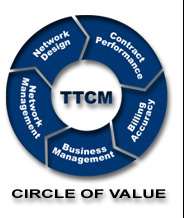




TTCM Savings Area:
Network Performance
Published In: Volume
3 Issue 5
Date: October,
2004
|
Keeping a network humming is a big job, enough to keep most telecom teams hopping day and night. But our responsibilities don't end with running cost effective networks that meet the needs of our user community. We must also make sure that we haven't put any of our constituents at risk, or opened our organizations up to avoidable liabilities. As a telecom manager this means we must ensure that all emergency calls are routed to the proper Public Safety Answer Point (PSAP) and that response teams are provided with sufficient information to locate the caller when they arrive.
E-911 is a service that provides authorities with the ability to pinpoint the exact location of anyone calling 911 in an emergency (even if the caller is unable to speak). This service is funded in part by business and residential telephone subscribers in the form of the FCC imposed 911 Surcharge on their monthly telephone bills. E-911 service requires 2 distinct functions, Automatic Number Identification (ANI) and Automatic Location Identifier (ALI). ANI is provided from the switch serving the caller and ALI is a database that matches the number to a physical address and is provided by the serving LEC. Figure 1 depicts the E-911 call set-up process for Residential and Business lines.
As you can see from Figure 1, this process is relatively simple in that the LEC provides the number of the caller, and the ALI database provides the location of the caller. Since the caller is using a single line phone, the Public Safety Answering Point (PSAP) is able to dispatch directly to the caller's location. Unfortunately this process becomes more complex with the introduction of PBX and/or Voice Over Internet Protocol (VOIP) gateways. Imagine an employee having chest pains while working alone late at night for a company with a large campus environment. Unless there is rigorous management of station locations, emergency personnel could easily be dispatched to the location where the calling trunk originates, while the caller may in fact be at another location. To ensure that accurate location information is provided to the PSAPs, businesses need to ensure that the following issues are addresses as depicted in Figure 2 below:
In recent years there has been a legislative push at both the federal and local level to require businesses to ensure E-911 compliance. Although the current laws vary by state, virtually all hospitals, nursing homes and schools with dormitories must already be compliant. Regardless of the status of the laws for your business, eventually you will need to be compliant, and if a 911 call goes wrong and it could be blamed in part to changes you made to your network, the civil suit could be enormous.
©2004,
TelAssess, Inc. All rights reserved. |
![]()
©2004, TelAssess 800.657.1595
Designed by Stylus
Designs


